In a crisis, our brains do one of three things: fight, flight or freeze. This built-in stress response happens in the amygdala within our brains and it can save us if we get attacked by a pack of wild dogs.
But the amygdala is not good at business strategy.
It’s both harder and much more important to be strategic during times of stress. Our response behavior to the crisis determines where we end up on the other side.
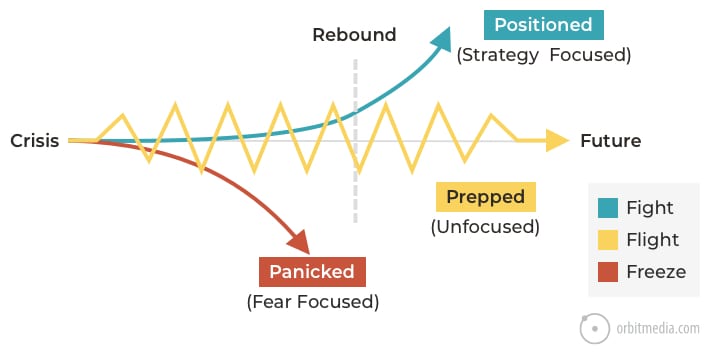
Here are 26 things we can do now to help get ready for the rebound broken up into three sections. The recovery is coming. Let’s reset and refocus on the marketing foundations, in any context.
- Digital Marketing Foundations
- PR, Content and Reputation Management
- Personal Development and Productivity
Digital Marketing Foundations
1. Update sales pages
Now is the time to improve the core of your website. These high-stakes pages often get ignored because marketers have article deadlines, even though visitors to these pages are 50x more likely to become a qualified lead.
Review the brochure sections of your site. Prioritize them based on traffic according to your Analytics. Use this checklist to make sure they’re working as hard as possible when the qualified traffic comes back.
10-point sales page checklist:
- Descriptive H1 headers
- Short paragraphs
- In-depth content that answers top sales questions
- Meaningful subheads (“Disaster Recovery Services” not “What We Do”)
- Faces of your people (not stock photos)
- Calls to action (better verbs than read, click, learn, contact)
- Statistics and data that support your value proposition or build trust
- Charts and graphs
- Trust seals (awards, memberships, partners, certifications)
- Testimonials
“How could you update your homepage at a time like this?” No one will say that. This is the perfect time to upgrade your website.
Not surprising that Jo Wiebe has a great approach for improving conversion content…
 |
Joanna Wiebe, COPYHACKERS“Start by doing 5-7 customer interviews, then use what you learn in those interviews to rewrite your new-lead nurturing sequence (or user onboarding sequence). Next, create 2-3 really great case studies (or hire Case Study Buddy to do it for you and support a small biz).” |
2. Gather and post testimonials
You have superfans. And there’s never been a better time to let others show their support for your brand. They want to help you survive and thrive. They’ll be glad you asked.
One simple email may get a quick response with a beautifully written testimonial, far more authentic than anything you could have written yourself.
Within ten minutes you can have this posted to a sales page, making your site stronger forever after.
 |
drew mclellan, AGENCY MANAGEMENT INSTITUTE“We have a limited window to prepare ourselves for a lot of pent up demand. Prospects are going to want to make up for lost time. You want to be the perfect choice so now is the time to get client testimonials (they’re on zoom all the time – might as well record a quick shout out), and freshen your home page to make it clear who you serve and how you help them. We know prospects prowl our sites long before they reach out – so polish up your first impression!” |
Need a few tips for how to reach out? Where and how to post them? Here’s our complete guide for adding testimonials. It’s got an email template you can use.
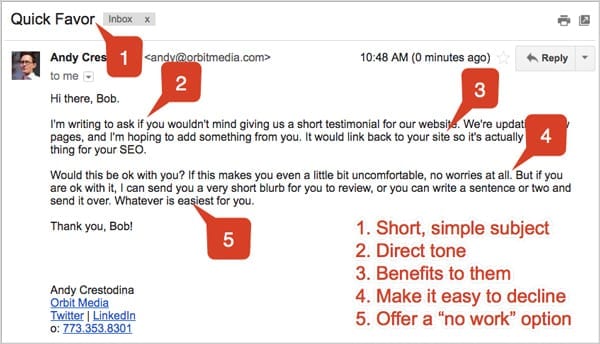
3. Audit your blog for traffic and conversions
Now that the money pages are tuned up, let’s look at the content marketing. You have high-performing and low-performing articles. But an audit will reveal precisely which URLs have which opportunities.
Jump into Analytics and find the posts with the greatest potential for improvement:
- Traffic Champions
They’re super visible. Squeeze more value from them by adding calls to action and internal links. Guide visitors from these to your highest converting posts. - Potential Champions
They’re on the edge of greatness. They rank high on page two of Google. Improve them by adding depth, detail and semantic SEO. - Falling Stars
They used to be traffic champs, but they’ve fallen from grace in Google. As above, rewrite and relaunch them. - Better Mousetraps
These may be low traffic, but people who find them love them. They turn readers into subscribers. Make these featured posts, link to them from traffic champs, schedule them for heavy social promotion in the recovery.
This handy chart is from our step-by-step guide for doing content marketing audit. Share it with anyone who is spending their quarantine on too much Netflix and not enough Analytics.
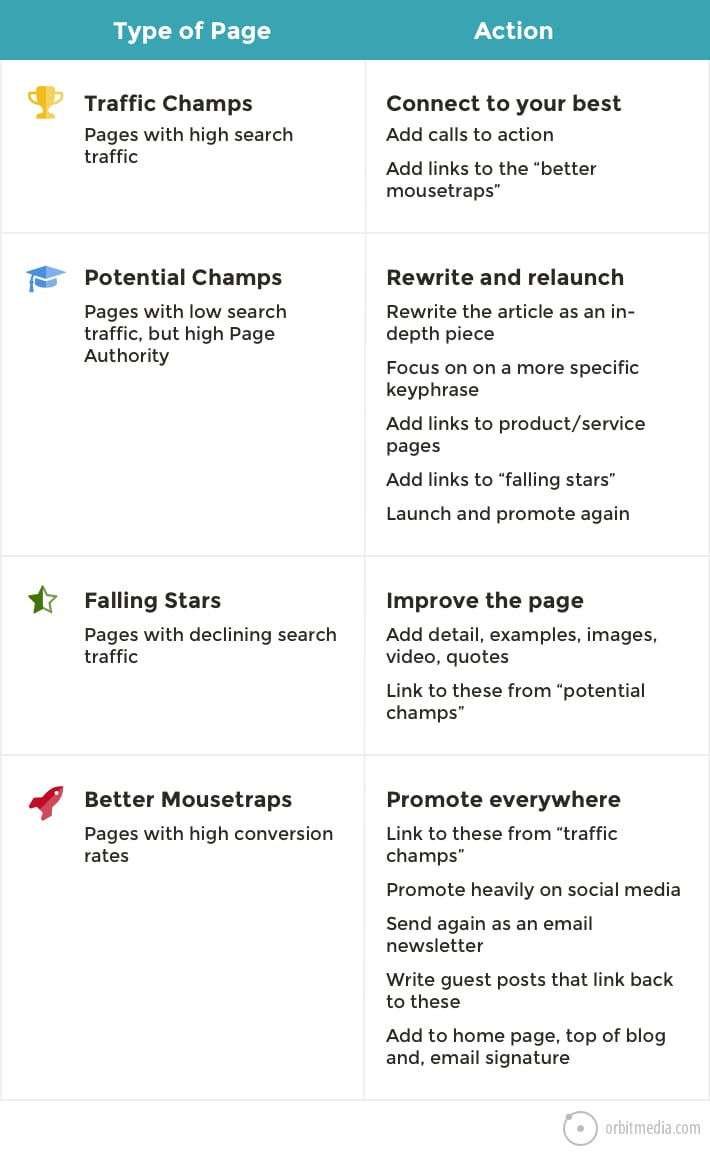
The basic idea is to shift from long-term plays to short-term ones.
 |
brad smith, USERP“New content on a new topic will take months (if not years) to rank successfully if you have no prior topical authority. So put it on the back burner and upgrade your current assets, first. Take your top performing content and update copywriting, images or design, etc. to squeeze out more conversions. You already know they’re working, so just make them work a little harder.” |
4. Prune your blog by deleting old content
I normally don’t think this is worth the effort. But if you suddenly have a lot of time on your hands, it might be a satisfying exercise to go through and delete things that didn’t make the cut from the audit.
When I wrote about it here, I basically disagreed with all of my contributors. Many SEOs think there’s a search ranking benefit to deleting a bunch of old posts.
Spring cleaning in your CMS may feel like “life changing magic.”

Personally, I think you’ll get better ROI from unsubscribing to 100 newsletters. Noise reduction.
5. Update your careers section
Over a short period of time, businesses are going to invite millions of people back to work. The jobs pendulum will likely swing back fast, especially for top talent.
When that ideal candidate visits your careers page, you have less than a minute to impress them. How does your look?
- Not so good: A empty page with an “open jobs” link to another website
- Awesome: A page filled with videos, awards, faces and stories from happy team members
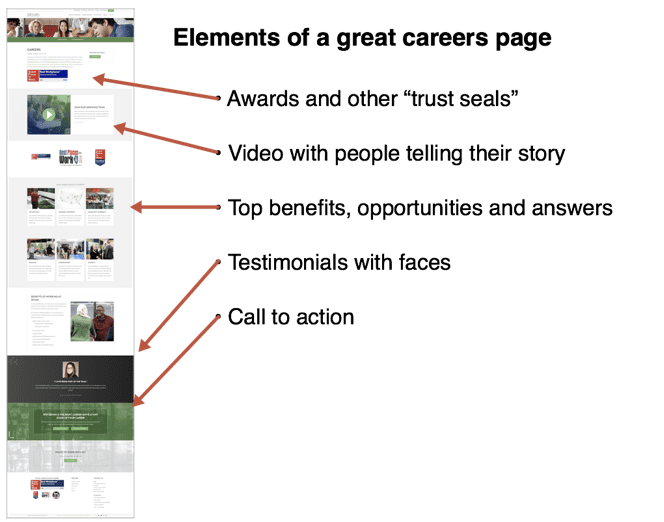
Even if you have no open jobs now, even if you just did a round of layoffs, it’s still a good time to polish this page. Sounds crazy, but this page is critical to your successful rebound.
Think ahead 6-12 months. Plan for success. If you need to staff up fast, you’ll be glad you fixed this now.
ProTip: Set up an HR playbook for onboarding new employees, conducting quarterly reviews, company policies, etc. This saves time, reduces risk and impresses your new talent.
6. Optimize your email signup CTAs
If you have content, you have an email signup box. But most email signup forms are terrible. They lack the 3 P’s of high converting signup forms:
- Prominence
It should visually stand out. It doesn’t have to be a popup window, but it should, at least, use strong color contrast and be available very close to your content. - Promise
It should tell people what they’ll get and how often they’ll get it. You’re trying to make an appointment with your audience. Commit to a frequency and tell them what it is. - Proof
It should include a third-party endorsement. You have very few subscribers in the beginning, so you can’t brag about the size of your list. Instead, use a testimonial quote from someone who loves getting your advice.
Here’s a mockup that shows all three P’s in action.
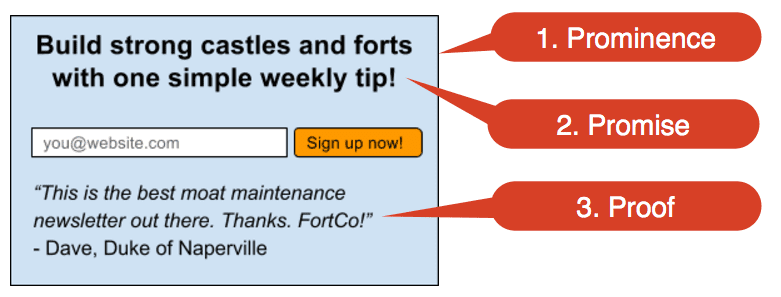
7. Check your thank you pages
If your thank you page just has two lonely words on it, it might as well say “good bye.”
The thank you page is the first touch with a converted visitor. Make it a good one. Here are five things you can add to your thank you pages:
- Expectations about what happens next
- A subsequent offer for another conversion (i.e. add email sign up forms to contact form thank you pages)
- Links to your most valuable content
- Ask them a question with a one-page survey
- Opportunities to follow your brand on social media
These are from our list of 15 things you can do to improve your thank you pages.
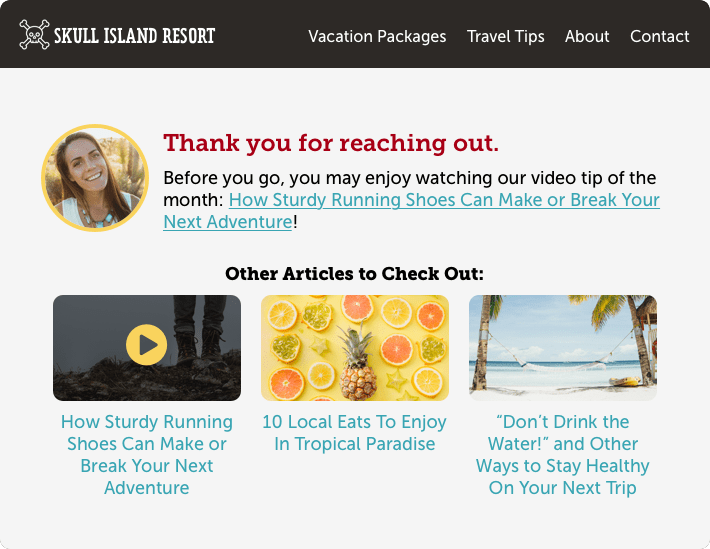
ProTip: If your website has thank you messages, rather than thank you pages (separate pages with their own URLs) then you’ve made tracking conversions in Analytics harder than it needs to be. Great websites have great thank you pages.
8. Update your auto response emails
Now that they’re on your list, welcome them with some content.
If you haven’t set up a series of welcome emails, sent automatically to new subscribers in a sequence, now is the time. It’s a set-it-and-forget-it source of tons of traffic. Here’s what ours looks like in Active Campaign:
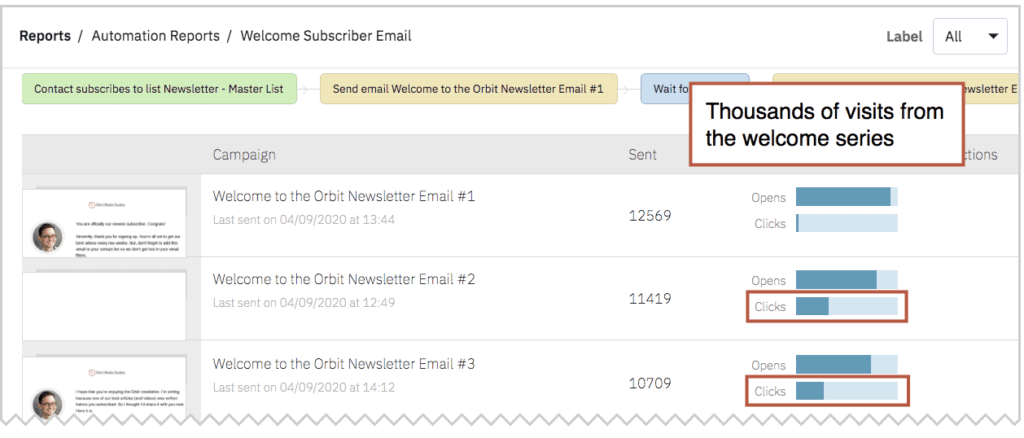
If you have set it up, this is a good time to review and improve it. Usually these emails invite the visitor to read your top performing (most shareable, most practical) articles. But if it’s been a while, your best may have changed. Your welcome series may be sending people old stuff.
Any other automatically generated emails you’ve ignored? Email receipts? Auto-responses from support? Accounting? Find and improve them all.
9. Tune up your popups
This is another set-it-and-forget-it list building tool that you may have forgotten about. In the recovery, these may have a positive impact …or they may be adding unnecessary friction for valuable visitors.
- Which of your pages have popups?
- Are those messages still current?
- How is this program performing? What’s the conversion rate?
If fewer than .5% of visitors are engaging with your popup, reconsider it. Change the offer, the design, the placement, the timing.
Popups are sometimes unnecessarily irritating.
Are you asking visitors who came from your newsletter to sign up for your newsletter? If so, that’s weird. And annoying.
10. Take new photos
If you ever wanted a beautiful springtime picture of the front of your building without a bunch of cars in front, now is your chance.

This is our building without any cars in front. Can you spot the Orbit logo?
11. Audit your “MarTech stack”
They’re the tools of our trade and we can’t do our jobs without them, from the CRM to the WordPress plugins. But your marketing technology might be a bloated pile of overlap and waste.
Make a spreadsheet for a quick informal audit. Here are your columns:
- The tool (include all SaaS tools, downloaded software and CMS plugins)
- The function
- The relative importance of that function (scale of 1-5)
- The frequency / utilization of the tool (1-5)
- The effectiveness (1-5)
- The cost
It’s likely that you’ll find things to cut before you finish the analysis.
Here at Orbit, I was surprised that we were using all of these tools for social media. We cancelled most of them and saved $287,900 per month.
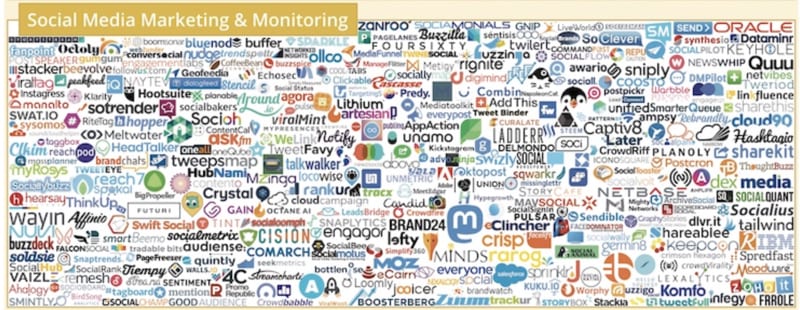
I’m kidding. That’s a small section of the famous MarTech Supergraphic. There are 7000+ marketing tools on it. Try them all!
12. Confirm that everything is in Google Tag Manager
Now that you have all of your tools listed in one place, make sure that your tracking tags are all in one place too: Google Tag Manager. (Not familiar? Amanda explains it here.)
It’s likely that you have tracking codes on your site or in CMS plugins that should really be managed in GTM.
For a quick check of all the codes installed on your site, use the Ghostery Chrome extension. In one click you can see every advertising and analytics tracking code you’re using. Then check GTM. Are they all in here? If not, migrate them in for better management and control.
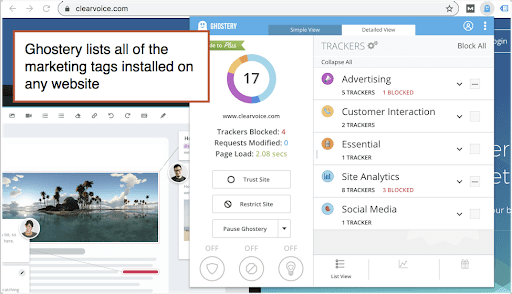
ProTip: Use Ghostery to see what your tools your competitors are using. Anything you should try?
13. Double-check your Google Analytics setup
Better data leads to better decisions. Take a half hour and confirm that Analytics is set up properly. Here are some questions to ask with a helpful video for each.
- Are goals, filters and site search set up properly? This is key to accuracy.
Related video: How to set up Google Analytics - Is content on subdomains tracked in our main view? Because traffic to your resources section should be tracked with everything else.
Related video: How to setup subdomain tracking - Are our video views tracked in Analytics? They can and should be using event tracking.
Related video: How to track video views in Google Analytics - Who has access to your Analytics? Add partners. Remove people you don’t work with anymore.
Related video: How to safely share access to Google Analytics
ProTip: Add an annotation showing when you made changes if you do anything that affects reports (filters, goals, etc.)

Once the data is as accurate as possible, you’re ready to do some quick analysis.
 |
Ben Swartz, MARCEL DIGITAL“Analyze your channel performance based on where those channels fall in your marketing funnel. Does the traffic to your homepage move through your site to service or blog pages? Or are those channels sending more traffic to service pages and case studies? And do those pages drive conversions once users land on them? Analyzing the data behind your traffic will help you understand if those channels are driving the right traffic and encouraging users to take the actions you want them to take.” |
14. Database and list cleanup
A sudden global emergency calls for quick outreach to clients and customers …which might have made you realize that your database of clients and customers may not be up-to-date.
Take this opportunity to tidy up tags in your CRM. While you’re at it, find and organize all of the many lists that content marketers build and use over time:
- List of clients and customers
- List of partners, influencers and collaborators
- List of journalists and columnists
- Lists for survey outreach and other research
Once done, sending outreach, invites and holiday gifts will be easier and faster.
Take it one step farther and improve your database with a bit of outreach.
 |
Sarah Steimer, American Marketing Association“We created a Google Survey for AMA members to sign up to be sources for our Marketing News publication. The survey asked them to list their area(s) of expertise, industry and location so we can reach out to them for relevant stories. This gives us a great Rolodex of experts we can tap when we’re working to quickly turn a story around.” |
PR, Content and Reputation Management
15. Google your brand and polish your branded SERP
Googled your business lately? What ranks? Like what you see?
Branded keyphrases are the first step in any SEO program (here’s a guide for finding all of your top branded keywords) People are likely searching for your brand today. But maybe you haven’t in a while.
- If you “sitelinks” under your company’s top organic listing, go make sure those pages are updated. They’re traffic magnets.
- If you see social profiles, go make sure those profiles are up-to-date.
- If you see negative reviews or low aggregate ratings, reach out to recent, happy customers for help.
- If you see a knowledge panel, make sure the business category, pictures and hours are all current. If not, fix them in your Google My Business account.
A few of these are worth diving into more…
16. Update your Google My Business (GMB) listing
This one comes from Local SEO pro, Mark Bealin of SearchLab:
 |
Mark Bealin, SearchLab“Make sure your GMB is optimized and ready for the “reset” – correct phone number, UTM tracking on your website link, correct hours, and have a Google Post ready for when things open back up. Prep some Q&A questions to load in and answer as soon as Google turns Q&A back on.” |
This is a great tip. We do this for the Orbit site. Now we can track all of our conversions from our GMB listing.
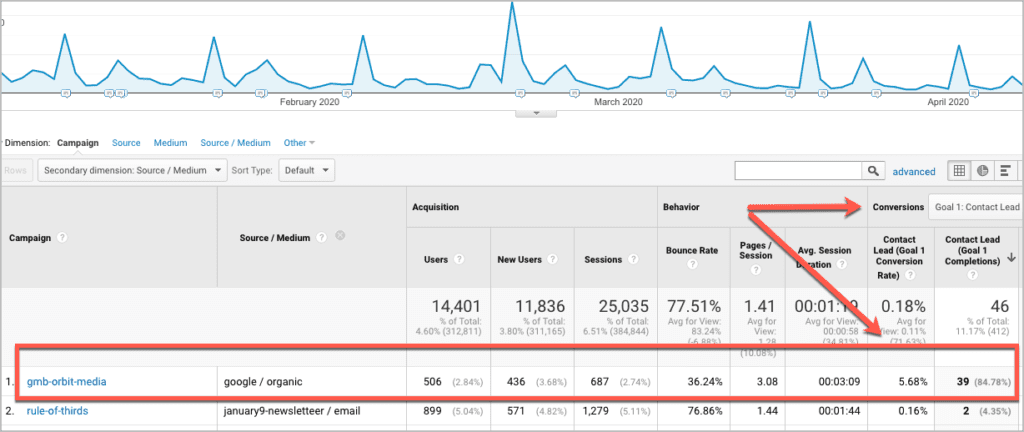
Related: Orbit’s URL Builder for adding campaign tracking codes.
17. Improve your reviews
Also related to local SEO, GMB and brander search results, reviews are foundational marketing that can be improved while campaigns are paused.
If you have low star ratings in Google, Yelp, Clutch, Facebook, BBB, G2, Glassdoor or anywhere else, this is an excellent time to move those scores up.
Similar to testimonials, you need to activate your fanbase.
But unlike testimonials, you’ll need more than just a few. Reach out to your last 20 clients. Thank them for the business, tell them you’re proud of the work you did. Are they happy too? If yes, in the follow up email, politely ask for a review.
 |
kristen mccabe, PERFORMANCE IMPROVEMENT PARTNERS“Clients are short on time too. This means even your biggest brand advocates can struggle to find the time to write a review or testimonial. Given that business may be slow for your customers too, and displaying reviews can increase conversion rates by 270%, now is the perfect time to reach out for testimonials and reviews. Build a library of testimonials you can turn to whenever you’re creating a new landing page.” |
The best way to build and maintain high scoring reviews is to put an ongoing program in place. Make it part of your standard process. Do it every time.
- Once work is complete, contact each customer and ask for feedback. If it’s strong, politely ask if they wouldn’t mind sharing that feedback online. (If it’s weak, address the service issue)
- Train customer service teams to listen for happy customers. When someone says something really nice (in any channel) capture the opportunity by asking them to share it online.
Speaking of Glassdoor, let’s position our brand for the hiring rebound.
18. Update your brand’s social bios
This one only takes a minute. Look at the social media profiles of your brand. Make sure they’re descriptive and that they go beyond the “who we are” text.
The best social profiles give the reader a reason to click the follow button, similar to an email newsletter signup CTA. In other words, they tell you what topics you’re going to put in their stream. Compare:
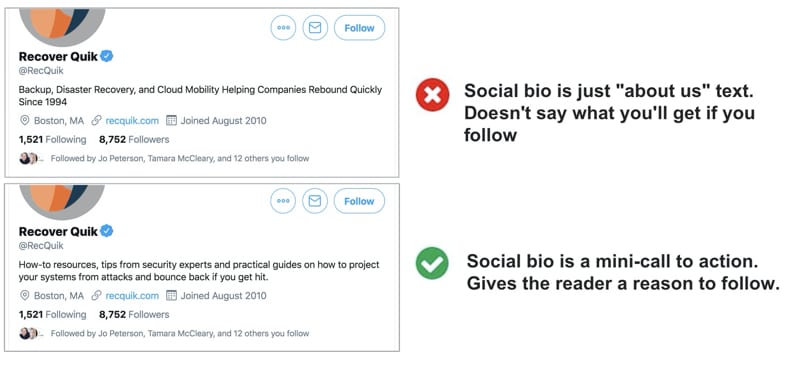
General rule: if you want someone to do something, give them a reason to do it.
ProTip: Remove hashtags from your Twitter bios. They’re not helping you be discovered. They’re exit signs that reduce engagement with your profile.
19. Set up a brand mention listening tool
When your brand gets mentioned on a blog or on the news, you want to know. If you get notified, you won’t miss the chance to share some positive press and to build a relationship with an editor.
You also don’t want to miss the chance to do a little link reclamation, which is a wonderful thing for your search rankings. It’s the easiest link win in SEO. And it’s free.
Here’s how it works:
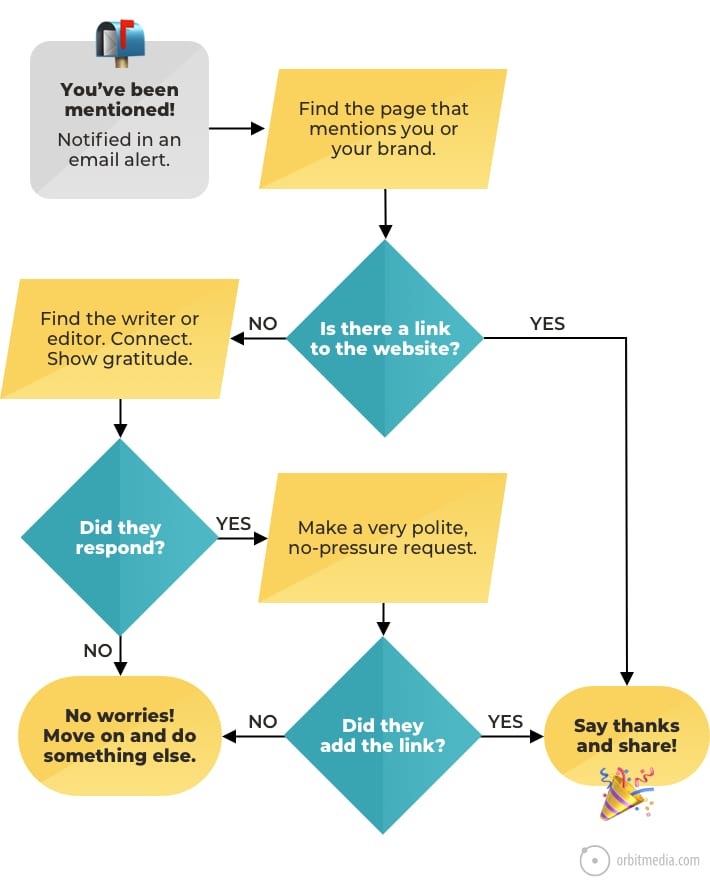
Detailed, step-by-step instructions (and email template) here.
20. Plan a big research piece
If you wait until things return to normal to plan a big piece of content, you missed your chance to do the deep work planning needed for large projects.
If you start the planning now (design the study, build the outreach list, line up your partners, start gathering data) you can get everything lined up while there are fewer interruptions.
Great idea. This tip comes from content and research pro, Amanda Milligan.
 |
amanda milligan, fractl“The content we create for our clients takes at minimum a month to produce. That’s not counting the process of coming up with the idea or the process of promoting the content. So, now’s a great time to invest in bigger content marketing projects that will get you a ton of ROI once things get back to the new normal.” |
21. Pre-record a new content program
Produce evergreen content that can be launched anytime. It may be possible to create a year of content in a high-value format (video, audio) in a few weeks.
- Record an entire season of a podcast
- Create a virtual summit of pre-recorded videos of experts giving presentations
- Shoot a series of how-to videos
 |
brad smith, userp“You literally can’t go anywhere right now. So what can you leverage right now that doesn’t cost a lot, but helps you produce a lot of end-product? Podcasts. You can record ~4 podcast episodes in the time it takes to create one in-depth written piece. Record them back-to-back to produce a months-worth of content in just a day or two each week.” |
Most content strategies are libraries, not newsrooms, which means that content can be produced far in advance. Consider the differences between the two types of content strategies.
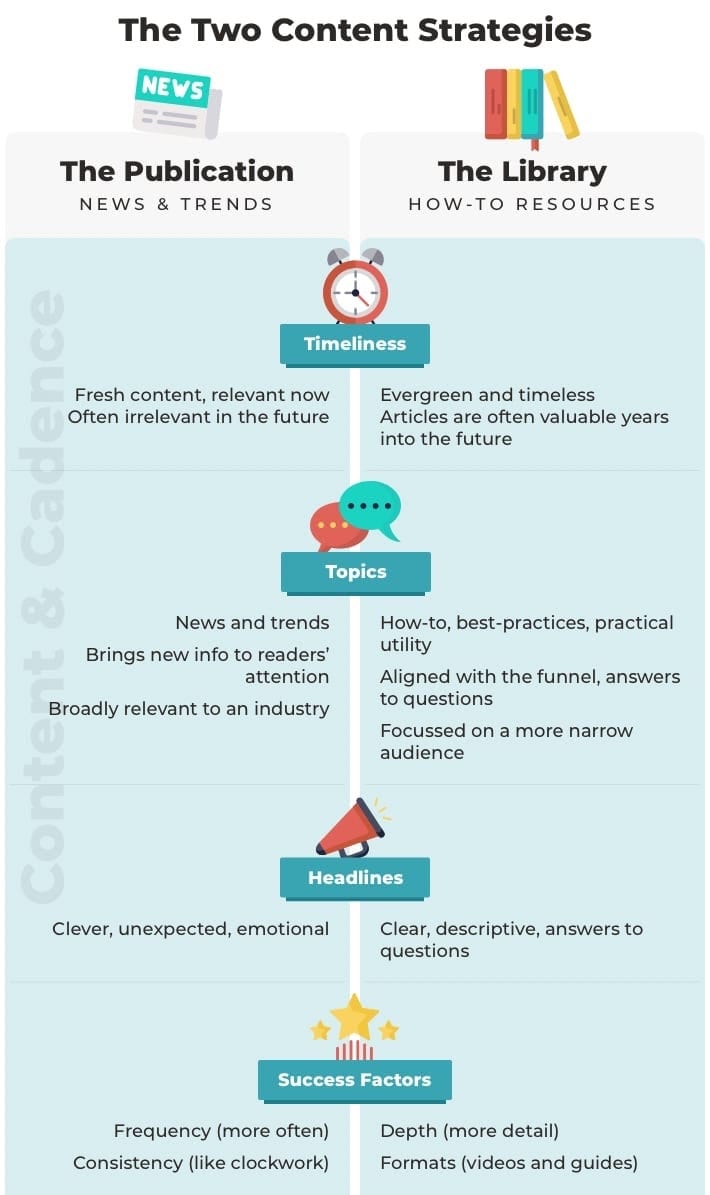
The full infographic and detailed breakdown are here.
Personal Development and Productivity
22. Invest in your skills
You know that thing that you always ask for help with? Now’s the time to learn it.
For me, it’s pivot tables. For you, it might be Google Tag Manager, something in WordPress or in your email service provider.
Focused learning starts with a plan. What do you want to know how to do? Where is the best content for learning it? Who can help you learn?
Here are things I’ve done in those moments where I’ve realized I needed to install new skills into my brain:
- Read one book on the topic, connect with the author
- Watch three videos on the topic
- Subscribe to a podcast on the topic
- Form a mastermind group of experts on that topic
- Budget 2 hours per week to study for three months
- Plan a project that requires the skill, during which I will have proved to myself that I have now acquired that skill
Imagine what your LinkedIn profile will look like in the future. Design your skill set, just like you would design anything else.
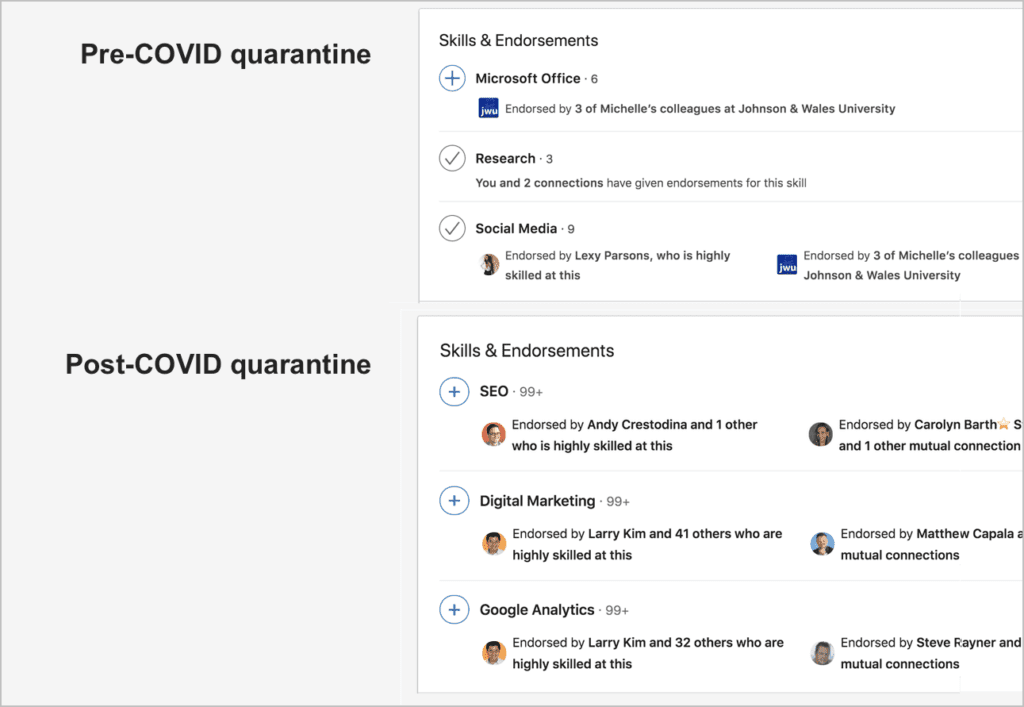
Study like it’s finals week and you’ll have a better brain in the rebound.
23. Document a process then delegate it
Content marketing drives traffic. Sales content converts visitors. But training content saves you time.
It’s the rarely mentioned cousin to the how-to article. It’s not for the public; it’s internal documentation. And it might save you eight hours a month. That’s an amazing outcome for a piece of content.
Look at your last 50 to-do list items. Which of those could have been delegated? Pick a few. Then create a detailed training guide (or better yet, a video) that shows exactly how to do it, step-by-step. Now you’re ready to hire a VA (it might be just a few hundred dollars a month) to do that for you forever.
Here are tasks that can be documented, then delegated.
- Publishing content to your CMS
- Setting up email newsletters in your ESP
- Social content scheduling and promotion
- Syndicating existing articles on LinkedIn (no, this duplicate content won’t hurt you)
- Scheduling interviews / outreach for collaboration
- Video production help (transcribe, captions, thumbnail graphics creation, etc.)
- Podcast production help (guest management, transcribe, publish, thumbnail, graphics creation)
This is how we do certain things at Orbit.
We met our VA through Don’t Panic Management.
Thank you for so many things, Emilee!
24. Work on your workspace
We all just learned the difference between good and bad video setups. Maybe invest a bit in your workspace / studio. Here’s a picture of my desk. Great for recording videos or just having a meeting.

Nothing in this picture (except the laptop) cost much more than a few hundred bucks. Get one new item every 3 months and in a year, you’ll look like a pro. Here’s the set up in order of importance.
- Rode Podcaster mic, $229
- Rode studio boom arm, $99
- Logitech HD webcam, $129
- Dimmable LED light, $70
- Acoustic panels, $67 each
The difference is huge. You will look and sound 10x better with just a little bit of gear.
25. Spiff up your email signature
If you send a lot of email, this is actually a highly visible bit of content. It may be landing in inboxes 50+ times per day. It’s killer personal branding.
Take a look at the signature of my buddy, Barry Feldman (powered by WiseStamp). It’s pretty amazing.
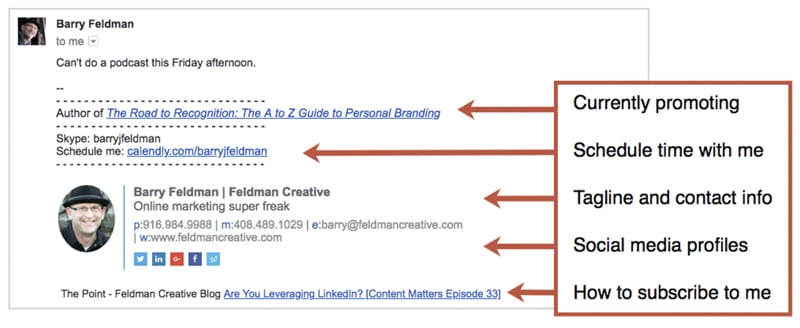
Do people really click on links in email signatures? Yes they do.
I added UTM tracking code to the link, so I can see the impact in Analytics. Last year it was 300 visits and 10 new subscribers. Not bad for 10 minutes of work.
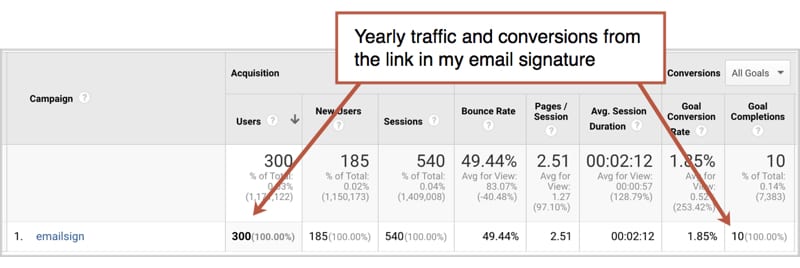
ProTip: Create a standard email signature for everyone in your company and help them set things up.
26. Develop new productivity habits
Skills are good. Habits are better. Once a habit is developed, it takes virtually no willpower to do things that might otherwise be really hard.
Ask a morning runner how they do it. They don’t think about it. They lace up their shoes and go.
Here are some things I’ve started in the last few years.
- Set up time blocking
Put deep work time (writing) and shallow work time (social media and email) on your calendar. - Test new email management tools and behaviors
There are great new tools to drive maximum efficiency from chaotic inboxes. I’m using Superhuman. It’s great. - Optimize your phone for focus
Focus is just the opposite of distraction. Remove apps and turn off notifications. Install a spam/scam call blocker (like Call Control).ProTip: Delete Facebook. The more boring you make your phone, the more productive you make your day. - Early to bed…
New rule: no scanning news headlines or social media feeds in bed. Bed is for books and sleeping. Get your rest, get up early and kick ass while your competitors snooze.
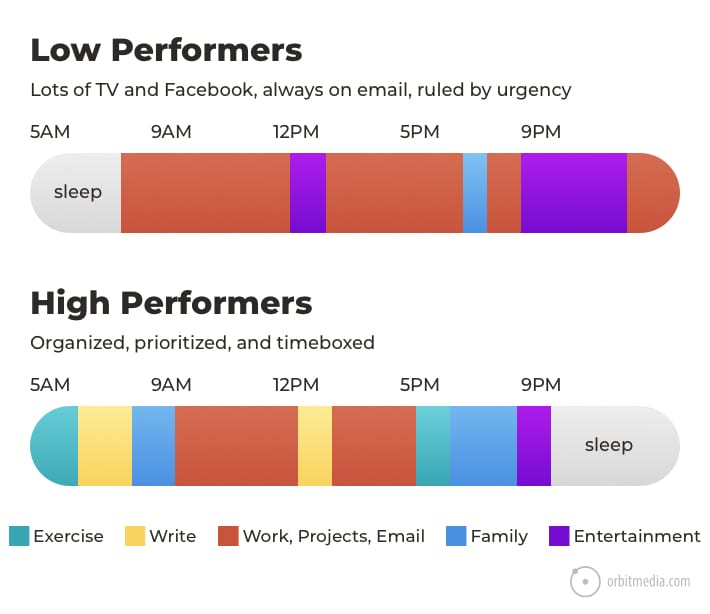
“Summer bodies are made in winter”
There’s a crossfit gym downstairs from the Orbit office. It’s closed of course, but this sign is still inside the front door. I love the message.
Let’s get moving.
Let’s do this.
When this winter ends, let’s be the first and fastest to get in front, compete and win in the rebound.

The post 26 Ways to Get Ready for the Rebound: A Playbook for What to Do Right Now appeared first on Orbit Media Studios.
from Orbit Media Studios https://www.orbitmedia.com/blog/get-ready-for-the-rebound/
via IFTTT
from
https://sarahbarnett0.wordpress.com/2020/04/15/26-ways-to-get-ready-for-the-rebound-a-playbook-for-what-to-do-right-now/
No comments:
Post a Comment